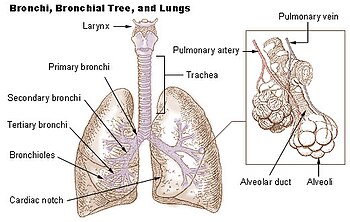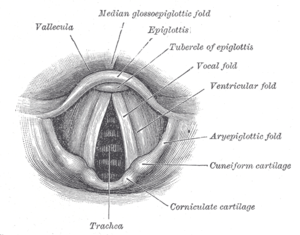Vocal pedagogy
Typical areas of study include:[1] All of these different concepts are a part of developing vocal technique.Not all voice teachers have the same opinions within every topic of study which causes variations in pedagogical approaches and vocal technique.It is unclear, however, whether the Greeks ever developed a systematic approach to teaching singing as little writing on the subject survives today.[2] The first surviving record of a systematized approach to teaching singing was developed in the medieval monasteries of the Roman Catholic Church sometime near the beginning of the 13th century.Other concepts discussed in the monastic system included vocal resonance, voice classification, breath support, diction, and tone quality to name a few.The physician and court singer Giovanni Camillo Maffei was the first writer on vocal pedagogy to incorporate knowledge of the physiology of the voice into a theory of singing in his treatise Discorso delta voce e del modo d'apparare di cantar di garganta, and Scala naturale, overo Fantasia dolcissima, intorno alle cose occulte e desiderate nella filosofia (Venice, 1564).It was during this time that teachers and composers first began to identify singers by and write roles for more specific voice types.With an effective singer or speaker, one should rarely be reminded of the process involved as their mind and body are so coordinated that one only perceives the resulting unified function.[1] Vocal resonation is the process by which the basic product of phonation is enhanced in timbre and/or intensity by the air-filled cavities through which it passes on its way to the outside air.Various terms related to the resonation process include amplification, enrichment, enlargement, improvement, intensification, and prolongation, although in strictly scientific usage acoustic authorities would question most of them.These adjustments and movements of the articulators result in verbal communication and thus form the essential difference between the human voice and other musical instruments.Since the vocal instrument is internal, the singer's ability to monitor the sound produced is complicated by the vibrations carried to the ear through the Eustachean (auditory) tube and the bony structures of the head and neck.Vibratory sensations resulting from the closely related processes of phonation and resonation, and kinesthetic ones arising from muscle tension, movement, body position, and weight serve as a guide to the singer on correct vocal production.Some terms sometimes used to describe a quality of a voice's sound are: warm, white, dark, light, round, reedy, spread, focused, covered, swallowed, forward, ringing, hooty, bleaty, plummy, mellow, pear-shaped, and so forth.A sunken chest position will limit the capacity of the lungs, and a tense abdominal wall will inhibit the downward travel of the diaphragm.Good body alignment allows the breathing mechanism to fulfill its basic function efficiently without any undue expenditure of energy.Voice Instructors have also noted that when singers assume good body alignment it often provides them with a greater sense of self-assurance and poise while performing.Many singers abandon conscious controls before their reflexes are fully conditioned which ultimately leads to chronic vocal problems.[14] The science behind voice classification developed within European classical music and has been slow in adapting to more modern forms of singing.So many premature diagnoses have been proved wrong, and it can be harmful to the student and embarrassing to the teacher to keep striving for an ill-chosen goal.When techniques of posture, breathing, phonation, resonation, and articulation have become established in this comfortable area, the true quality of the voice will emerge and the upper and lower limits of the range can be explored safely.A register in the human voice is a particular series of tones, produced in the same vibratory pattern of the vocal folds, and possessing the same quality.However, many voice instructors disagree with this distinction of boundaries blaming such breaks on vocal problems which have been created by a static laryngeal adjustment that does not permit the necessary changes to take place.However, some areas of the art of singing are so much the result of coordinated functions that it is hard to discuss them under a traditional heading like phonation, resonation, articulation, or respiration.Voice instructors teach that a singer can only achieve this goal when all of the physical processes involved in singing (such as laryngeal action, breath support, resonance adjustment, and articulatory movement) are effectively working together.If required they may also spend time helping their students become better sight readers, often adopting solfège, which assigns certain syllables to the notes of the scale.Many voice instructors will spend time on acting techniques and audience communication with students in these fields of interest.Students of opera also spend a great deal of time with their voice teachers learning foreign language pronunciations.






1. Exo-labial, 2. Endo-labial, 3. Dental, 4. Alveolar, 5. Post-alveolar, 6. Pre-palatal, 7. Palatal, 8. Velar, 9. Uvular, 10. Pharyngeal, 11. Glottal, 12. Epiglottal, 13. Radical, 14. Postero-dorsal, 15. Antero-dorsal, 16. Laminal, 17. Apical, 18. Sub-apical
Musical techniqueAbductionadductionPrecursorN. laryngeus recurrensN. laryngeus superiorAnatomical terminologysingingHuman anatomyphysiologyPosturePhonationVocal resonationvoice projectionVocal registrationSostenutolegatovibratocoloraturavoice disordersart songPhoneticsVoice classificationvoice teachersPythagorasThe School of AthensRaphaelAncient GreeceAlypiusmedievalmonasteriesRoman Catholic ChurchJohannes de GarlandiaJerome of Moraviavocal registerschest voicethroat voicehead voicefalsetto registervocal resonanceBel CantoRenaissanceBurgundyBurgundian SchoolFranco-Flemish SchoolcastratoBaroqueoperasGiovanni Camillo MaffeiGiulio CacciniClassicalRomanticvoice typescoloratura sopranolyric sopranolaryngoscopeManuel Patricio Rodríguez GarcíaMathilde MarchesiIndiana UniversityOren BrownWashington University School of MedicineJuilliard SchoolWilliam VennardUniversity of Southern CaliforniaRichard MillerNational Association of Teachers of Singingrespirationresonationarticulationlarynxvocal foldsvocal tractvocal apparatusarytenoid cartilagestracheal treepharynxoral cavitynasal cavitysinusesPlace of articulationlabial consonantscoronal consonantsdorsal consonantsepiglottispharyngeal consonantsglottisglottal consonantslaminal consonantsapical consonantssub-apical consonantsvowelsconsonantsInternational Phonetic Alphabethuman voicediaphragmvibrationsBreathingsubconscioussingerVoice typeVoice classification in non-classical musicSopranoMezzo-sopranoContraltoCountertenorBaritoneclassical musicmusical instrumentsComposersvocal rangevocal weightvocal tessituratimbrevocal transition pointstreblechoral musicContemporary Commercial Musicstyle of musicWhistleFalsettoVocal frylaryngealpitchesresonancephonatorylanguage